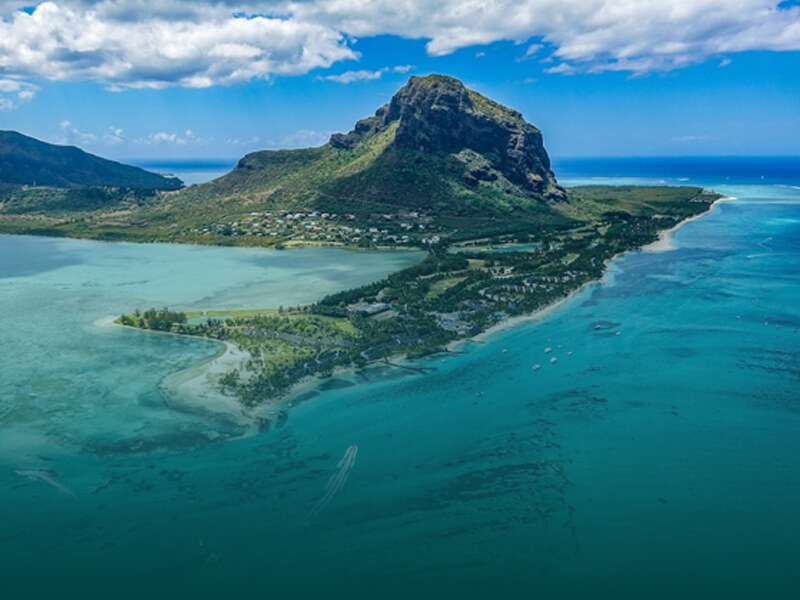Fauna & Flora of Rodrigues
Throughout history, we have all witnessed about how the first sign of colonisation has caused much destruction not only to the indigenous people, but also to nature as a whole, the indigenous flora and fauna which used to flourish has now become extinct or are today endangered.
.jpg)
.jpg)
Known for its rich biodiversity, Rodrigues Island was once flourished with an abundant of endemic plant and animal species. It was home to now extinct flightless bird, the Rodrigues solitaire (Pezophaps solitaria) which had to face the same fate just like the dodo of Mauritius.
Over the years the local government together with its people have made a great effort to restore some of the forest areas such as Grande Montagne, Anse Quitor and two islets, Ile aux Sables and Ile aux Cocos which have been declared as nature reserves.
With the untiring efforts of the locals, the island is slowly turning into an ecological haven, where conservation is on the top list of the government agenda. Some of the non-profit organisations, and the local communities collaborate with the local government to work together towards building a sustainable green Rodrigues.
There are many educational programmes that have been designed to educate students, as from the very early age, in conserving their natural heritage and at the same time becoming aware of the environmental issues facing Rodrigues.
Let’s now get much deeper into the flora and fauna of this little island:
Rodrigues Island Flora
There have been many factors affecting the once luxuriant flora of the island, such as deforestations, long drought periods and the over exploitation of certain plants used in medicine or as raw material in the production of handicraft works.
.jpg)
Not until recently, Rodriguans has started to realise the importance of preserving their natural heritage, and towards building Rodrigues into an ecological island.
For instance, beautiful mangrove shrubs have been planted in the lagoons to curb erosion. Certain zones have been declared as nature reserves and reforestation operations have been undertaken. More than 3500 people are actively engaged in these projects. The people of Rodrigues have shown a genuine enthusiasm in getting started in the cultivation of endemic plants.
While exploring the island, you will likely notice trees and bushes scattered widely all over the island, such as the casuarina trees, lataniers, vacoas, aloes, lemon trees and vetiver. There is also a unique plant specific to the island, known as “vieille-fille” (old maid), a kind of small shrub with pink flowers that are infused to make a drink.
There are also some of the rarest plant, having unusual name such as café marron (brown coffee), bois pipe (pipe wood), bois de mangue (mango wood), bois de fer (iron wood), bois chauve souris (bat wood), bois cabri (goat wood), and bois puant (stinking wood).
With the collaboration of the Forestry Service and nature conservation organisations, today a larger and improved nurseries has been erected in certain places such as Solitude, Grande Montagne and Anse Quitor Nature Reserves, and more recently Ile Cocos and Ile aux Sables. At Solitude, plants are also produced for private restoration projects, such as the François Leguat Giant Tortoise and Cave Reserve.
Anse Quitor-Nature Reserve
Anse Quitor, has been serving as a nature reserve since 1996. The nature reserve is located near the Sir Gaetan Duval Airport, nearly at sea-level, with coralline substrate, and in a relatively dry area.
.jpg)
Home to very rare endemic plants such as the Zanthoxylum paniculatum and Gastonia Rodriguesiana, Anse Quitor Nature Reserve has seen the planting of 3,000 endemic seedlings yearly up to 2008. At present, about 14 hectares of the 34 hectare native forest have already been restored and many rare plants of Rodrigues have been planted in this reserve.
The Solitaire Bird of Rodrigues
Once abundant in numbers, the unique and graceful Solitaire had to face the same ill-fate as the dodo on Mauritius. The bird was widely described by François Leguat in his memiors which were published in 1708. Until 1875, when solitaire skeletons were found, his descriptions were considered fanciful. Archaeology finally upheld much of what he had written and his descriptions are now taken seriously. Leguat described the solitaires' mating dances and displays; the birds whirred their short wings and clapped them “like a rattle” against their sides. They guarded their nests and single chicks and were territorial driving away other solitaires from their territory. They also mated for life as. “these two Companions never disunite”.
.jpg)
Unlike Dodo, Solitaire was described as delightfully beautiful and delightfully edible”, with one early observer writing, “the females are wonderfully beautiful, some fair, some brown. They have a sort of Peak, like a window’s upon their Beak, which is of a dun colour.
The feathers on their thighs are round like shells at one end, and being there very thick, have an agreeable effect. They have two risings on the craws, and the feathers are whiter there than the rest, which lively represents the fine bosom of a beautiful woman.
They walk with so much stateliness and good grace, that one cannot help admiring and loving them.
Today apart from their skeletons, and historical accounts, nothing is left. It is believed that they have been the targets of passing sailors and famished settlers.
Today, you can find few places on the island where Solitaire remains can be viewed such as at Grande Montagne Museum; Mauritian Wildlife Foundation, Forestry Quarters, Solitude, François Leguat Tortoise and Caves Reserve, at Plaine Corail.
The Rodrigues Endemic Tortoises
According to historical records, tortoises were initially abundant on all of the islands, with possibly 300,000 individuals at the time of François Leguat in 1691. However, all species became extinct shortly after man arrived on the islands, with the last giant tortoise being seen on Rodrigues during the late 1700s. Their disappearance is blamed on the intensive harvesting by man (for oil and food) and the predation of eggs and juveniles by the introduced pigs and rats. At the end of the 18th century, the tortoises had disappeared and the last Solitaire was dying.
Aldabra Tortoise-The Giant Tortoises
It is claimed that Rodrigues had two endemic species of giant tortoises, notably, Cylindraspis peltastes and Cvosmaeri. While, visiting the François Leguat Nature Reserve, one can spot the Aldabra tortoises, which are the last surviving giant tortoise that once inhabited the Indian Ocean islands. These type of tortoises have special adaptations for grazing short vegetation and drink from shallow pools.
.jpg)
It is interesting to know that the giant tortoises which are now seen in Mauritius are mostly derived from animals imported to Mauritius from the Seychelles in the 1880's, following the recommendation of Charles Darwin, who was concerned that the Aldabra species would become extinct. He wanted to have captive breeding of endangered species as a conservation measure. Following Darwin’s intervention, the governor of Mauritius and the Seychelles agreed to the introduction of the tortoise to Pamplemousses Botanical Garden.
Radiata Tortoise
.jpg)
Apart from the Aldabra, you will find the Radiata tortoises at the reserve. They are considered to be one of the most beautiful tortoises in the world, with a carapace(shell) decorated with brilliant yellow lines radiating from the centre of each plate, creating a very distinctive pattern which also provides them with camouflage in their natural habitat.
During French rule and continuing into the 1930s, huge numbers of radiated tortoises were exported to Réunion and Mauritius from Madagascar, principally for food. However, large numbers were kept as pets and have been bred on both islands ever since.
In the wild in Madagascar this species is rapidly declining in numbers due to habitat destruction, hunting for food and over-exploitation for the pet trade.
Rodrigues Flying Fox
The scientific name of the Rodrigues flying fox is Pteropus rodricensis, a species of bat in the family Pteropodidae, which was in abundance in Mauritius, today is predominately found in Rodrigues. The mammal is usually referred to as Golden Fruit Bat.
.jpg)
These bats are considered as sociable, and they are roost in large groups during the day and feed at night by squeezing the juice and flesh out of the fruits. Their natural habitat is tropical lowland forests. Unfortunately, they are hunted by humans for food or because they caused much nuisances at night, and due to this their numbers have been dwindling.
The International Union for Conservation of Nature has rated these species as being “critically endangered“. In an effort to preserve them from extinction, some bats have been caught and are being bred in various zoos around the world.
These bats are also threatened by cyclones, one of which severely affected the population in 2003 in the island. Regular bat surveys are also conducted at the Cascade Pigeon roost, which is one of the major roost sites.
From these surveys it has been found that the number of individuals now stands at around 9,000. To continue with this level of monitoring, volunteers from the local community have been trained to carry out some of the work
Much is being done to save these species, for instance, an Annual Bat Day Festival was organized in 2009 and 2010 to sensitize the public about this species and its importance in the ecosystem across Rodrigues. The festival included an exhibition on the bat, newspaper articles, radio talks, activities in schools, and an opportunity for the public to participate in a bat survey. A bat poster and sticker were also created for distribution on this occasion.
Rodrigues Seabirds and other Species
.jpg)
If you are a bird enthusiast, then you can find thousands of marine birds which have sought shelter on protected islets and scattered in the lagoon of Rodrigues.
.jpg)
Some of them are the Brown Noddy (nicknamed “mandarin”), the frigate bird, the Sooty tern (also called “yéyé”) or the White tern (“the Virgin bird”). These bird sanctuaries are well protected and seabird monitoring surveys are now carried out yearly on Ile Cocos and Ile aux Sables.
Other interesting inland animal species are the two endemic and endangered species that can still be observed: the Yellow Rodrigues Fody (Foudia flavicans) and the Rodrigues warbler (Acrocephalus rodericanus).
Whist, the fauna is seemingly richer underwater, with the 90 km-long coral reefs catering for an eclectic range of fishes and invertebrates.












